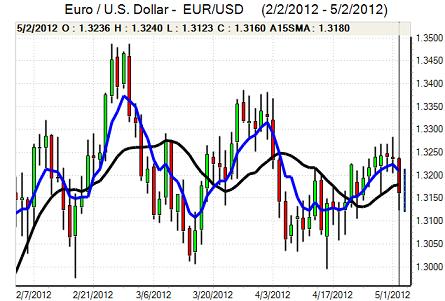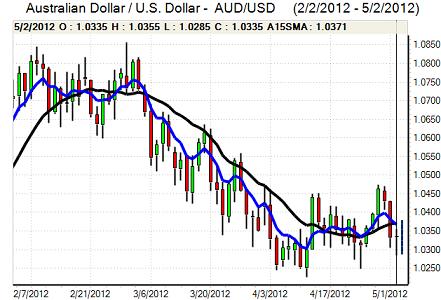EUR/USD
The Euro was subjected to heavy selling pressure in Europe on Wednesday due to a combination of fundamental and technical factors. The final Euro-zone PMI manufacturing index edged lower to 45.9 from a flash estimate of 46.0, although principal attention focussed on the peripheral economies as the Italian index deteriorated sharply for April. There were also depressed readings for the Spanish and Greek economies which maintained fears over the outlook.
The German unemployment data was weaker than expected with an increase of 19,000 for April and there was an increase in the Euro-zone as a whole to 10.9% as Spanish youth unemployment remained above the 50% level.
There were further defensive inflows into German bonds as yields dipped to record lows on capital flight from peripheral economies. In this environment, the Euro dipped to lows just above the 1.31 level.
The latest US ADP employment report was weaker than expected with a 119,000 increase for April following a revised 201,000 gain previously. The report served to dampen optimism surrounding Tuesday’s PMI report and there were increased doubts surrounding Friday’s payroll report which curbed dollar support.
There was also speculation that the ECB could move closer to another long-term refinancing operation at Thursday’s council meeting which helped provide some relief to the Euro and there was some positive news with Standard& Poor’s lifting Greece’s credit rating out of selective default. The Euro was blocked in the 1.3160 region as underlying sentiment remained generally weaker with fears that policy options were very limited.

Source: VantagePoint Intermarket Analysis Software
Call now and you will be provided with FREE recent forecasts
that are up to 86% accurate* 800-732-5407
If you would rather have the recent forecasts sent to you, please go here
Yen
The dollar was unable to hold above 80.50 against the yen on Wednesday and retreated back towards the 80.25 region. The weaker than expected US ADP report was significant in undermining yield support and the dollar tested support in the 80 region.
The yen was hampered by a Moody’s report which warned over the negative impact of any delay in raising the sales tax. There will be further pressure from the Japanese Finance Ministry for yen gains to be resisted which discouraged yen buying.
Tokyo markets were again closed on Thursday which limited movement on Thursday. There was a generally cautious tone surrounding risk appetite with warnings over the Asian economic outlook serving to dampen risk appetite and also maintaining pressure for Japan to keep a competitive currency.
Sterling
Sterling hit resistance in the 1.6230 region against the dollar on Wednesday and dipped to lows around 1.6160 before recovering ground and consolidating just below the 1.62 level. Principal attention focussed on the Euro/Sterling cross as the UK currency advanced to a 22-month high near the 0.8110 level.
The latest PMI construction index dipped to 55.8 for April from 56.7 the previous month, but this was stronger than expected and there was speculation that there would be an upward revision to the first-quarter GDP data.
There was a solid rise in UK lending for March, but there was a further decline in money supply which will increase fears surrounding the growth outlook as credit conditions remained extremely tight. Although there has been speculation over defensive inflows into Sterling, official data recorded net capital outflows of gilts for February and March. The services-sector PMI data will be watched very closely on Thursday and a firm reading would lessen pressure for further Bank of England monetary action. The Nationwide reported a 0.2% decline in house prices for April.
Swiss franc
The dollar pushed sharply higher in Europe on Wednesday with a peak just above 0.9150 on wider US currency gains. The Euro managed to eke out a marginal advance against the Swiss currency with ranges still extremely narrow.
The latest PMI report was sharply weaker than expected with a decline to 46.9 for April from 51.1 previously which will maintain pressure on the National Bank to resist any renewed franc gains. A shortage of viable defensive currencies could still trigger a determined attack on the 1.20 Euro minimum level and force more aggressive National Bank action.

Source: VantagePoint Intermarket Analysis Software
Call now and you will be provided with FREE recent forecasts
that are up to 86% accurate* 800-732-5407
If you would rather have the recent forecasts sent to you, please go here
Australian dollar
The Australian dollar was blocked firmly close to the 1.0350 level against the US currency on Wednesday and was subjected to renewed pressure with a low before 1.03 before finding buying interest close to channel support just below this level.
There were expectations of further interest rate cuts in the medium term while the weak Euro-zone growth data limited the scope for any improvement in risk appetite which also held the currency back. There were further concerns surrounding the Asian growth outlook which curbed Australian dollar support and the domestic economic data remained weak with the services-sector PMI index dipping very sharply to 39.6 for April from 47.0.



